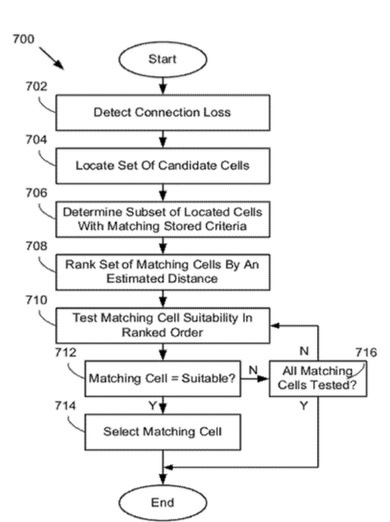An Apple patent (number 8301145) for fast cell selection in a mobile wireless device has appeared at the U.S. Patent & Trademark Office.
Per the patent, the mobile wireless device detects when a first wireless cell fails a set of stored suitability criteria and searches for and locates a set of candidate wireless cells to associate with. The mobile wireless device measures at least one received signal metric for each candidate wireless cell in the set of candidate wireless cells.
When a candidate cell in the set of candidate wireless cells is identically the first wireless cell, the mobile wireless device evaluates the suitability of the candidate wireless cell using the stored set of suitability criteria for the first wireless cell and the measured at least one received signal metric for the candidate wireless cell. The mobile wireless communication device associates with the candidate wireless cell when the candidate wireless cell meets the stored set of suitability criteria.
Here's Apple's background on the invention: "Mobile wireless communication devices, such as a cellular telephone or a wireless personal digital assistant, can provide a wide variety of communication services including, for example, voice communication, text messaging, internet browsing, and electronic mail. Mobile wireless communication devices can operate in a wireless communication network of overlapping 'cells.' each cell providing a geographic area of wireless signal coverage that extends from a radio network subsystem located within the cell.
"The radio network subsystem provides an 'air interface' through which the mobile wireless communication device can access the wireless communication network. Whether idle or actively connected, a mobile wireless communication device can be associated with a 'serving' cell in a wireless communication network and be aware of 'neighbor' cells to which the mobile wireless communication device can also associate.
"The quality of the air interface between the mobile wireless communication device and the radio network subsystem can vary based on the distance between them and on interference included in received signals at either end of the air interface. As the mobile wireless communication device moves further away from the radio network subsystem, eventually a neighbor cell can provide an equal or better performing communication link than the current serving cell.
"The mobile wireless communication device can include a process for determining if and when to switch cells with which it associates. If the mobile wireless communication device is actively connected to the serving cell, then the process of switching to a neighbor cell is known as 'handoff.' For a mobile wireless communication device that is associated with a serving cell in an 'idle' state, the process of associating with a neighbor cell is known as 'cell reselection.'
"When a mobile wireless communication device seeks to associate with a wireless communication network, such as after a power on initialization, the mobile wireless communication device can search for cells located in its vicinity. Initially locating and connecting to a serving cell by a mobile wireless communication device can be referred to as 'cell selection.' If a cell is located that is deemed suitable to provide a wireless communication link, e.g. when signals received by the mobile wireless communication device from the radio network subsystem located in the cell exceeds certain performance quality metrics, then the mobile wireless communication device can associate with that cell.
"The mobile wireless communication device can be referred to as being 'camped' on a particular 'serving' cell in the wireless communication network of cells. While camped on the serving cell, the mobile wireless communication device can listen to messages broadcast from the serving cell's radio network subsystem as well as from other radio network subsystems located in neighbor cells.
"System information that specifies certain properties of the serving cell and its neighbor cells can be broadcast regularly by the serving cell's radio network subsystem. If the mobile wireless communication device determines that a neighbor cell can provide a higher quality communication link than a current serving cell, then the mobile wireless communication device can disassociate from the current serving cell and associate with the neighbor cell, in a process known as 'cell reselection.'
"Initial cell selection and cell reselection can include reading a number of different system information messages transmitted by the radio network subsystems in the wireless communication network. Each system information message can be transmitted at regular intervals. By waiting to read the system information messages when broadcast, the mobile wireless communication device can be assured of using the latest system parameter values during the cell evaluation process.
"Some of the system information messages can change infrequently, however, and the mobile wireless communication device can incur an unnecessary delay when waiting to read the most recent system information if the same information has been read before. For example, when there is a momentary or short time interval loss of service by the mobile wireless communication device or when the mobile wireless communication device reacquires the same cell as previously used, it can be desired to shorten the lengthy cell search and selection procedure by reusing system parameters that were read earlier and stored in the mobile wireless communication device."
The inventors are Giri Prassad Deivasigamani, Venkatasubramanian Ramasamy, Sharad Garg and Srinivasan Vasudevan.














